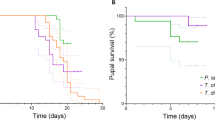Abstract
Leaf beetles of the speciesTrirhabda geminata are specialized herbivores that are able to feed on the chemically well-protected foliage of the desert sunflowerEncelia farinosa, which contains the insecticidal chromene derivative encecalin. Chemical analysis of the beetles and their fecal excretions indicated that encecalin is present only in the alimentary canal and is not absorbed across the gut membrane, as previously shown for other herbivorous insects (e.g., the Egyptian armyworm,Spodoptera littoralis) that are susceptible to this chromene derivative. Further differences betweenT. geminata and nonadapted insects were observed with regard to the metabolism of encecalin. Whereas the encecalin-resistent leaf beetles metabolize encecalin mainly to encecalol by reduction of the acetyl group, susceptible insects, such as larvae ofS. littoralis, metabolize encecalin mainly by exoxidation of the 3,4 double bond, which creates a powerful alkylating agent and is responsible for the toxicity of encecalin. Reductive rather than oxidative metabolism of encecalin therefore seems important for the resistance ofT. geminata against the chemical defense of their host plantE. farinosa.
Similar content being viewed by others
References
Geissman, T. A., andMukherjee, R. 1968. Sesquiterpene lactones ofEncelia farinosa Gray.J. Org. Chem. 33:656–660.
Hogue, S. M. 1970. Biosystematics of the genusTrirhabda Leconte of America north of Mexico (Chrysomelidae: Coleoptera). Dissertation. University of Idaho.
Isman, M. B., Yan, J.-Y., andProksch, P. 1986. Toxicity of natural chromene derivatives to a grasshopper.Naturwissenschaften 73:500–501.
Isman, M. B., Proksch, P., andWitte, L. 1987a. Metabolism and excretion of acetylchromenes by the migratory grasshopper.Arch. Insect. Biochem. Physiol. 6:109–120.
Isman, M. B., Yan, J.-Y., andProksch, P. 1987b. Insecticidal chromenes from the Asteraceae: Structure-activity relations.Entomol. Exp. Appl. 43:87–93.
Kunze, A. 1995. Chromene aus Asteraceen als chemischer Fraßschutz gegen herbivore Insekten. Dissertation. Bayerische Julius-Maximilians-Universität, Würzburg, Germany.
Kunze, A., Müller, C., andProksch, P. 1995. Chemical variation and defense ofEncelia farinosa.Biochem. Syst. Ecol. 23:355–363 (1995).
Paine, T. D., Redak, R. A., andTrumble, J. T. 1993. Impact of acidic deposition onEncelia farinosa Gray (Compositae: Asteraceae) and feeding preferences ofTrirhabda geminata Horn (Coleoptera: Chrysomelidae).J. Chem. Ecol. 19:97–105.
Proksch, P., andKunze, A. 1995. Chemosystematic evidence from prenylated acetophenons—conclusions at the tribal, inter- and intrageneric level,In Compositae, Systematics, Biology, Utilization. Proceedings of the Compositae Conference, Royal Botanic Gardens, Kew. In press.
Proksch, P., andRodriguez, E. 1982. High-performance liquid chromatography of chromenes and benzofurans from the genusEncelia (Asteraceae).J. Chromatogr. 240:543–546.
Proksch, P., andRodriguez, E. 1983. Chromenes and benzofurans of the Asteraceae, their chemistry and biological significance.Phytochemistry 22:2335–2348.
Proksch, P., andRodriguez, E. 1984. Distribution of chromenes and benzofurans inEncelia californica.Biochem. Syst. Ecol. 12:179–181.
Proksch, P., Isman, M. B., Witte, L., andHartmann, T. 1987. Metabolites of insecticidal chromenes from the migratory grasshopperMelanoplus sanguinipes.Phytochemistry 26:2227–2230.
Randriaminahy, M. 1992. Phenolische Inhaltsstoffe aus Asteraceen: Phytochemie und Biotransformation in Raupen des NachtfaltersSpodoptera littoralis. Dissertation. Bayerische Julius-Maximilians-Universität, Würzburg, Germany.
Randriaminahy, M., Witte, L., Kunze, A., Wray, V., andProksch, P. 1992. Detoxification of naturally occurring chromenes in larvae of the generalist herbivoreSpodoptera littoralis (Noctuidae).Biochem. Syst. Ecol. 22:711–722.
Röder, E. 1984. Wie verbreitet und wie gefährlich sind Pyrrolizidinalkaloide?Pharm. Unserer Zeit 13:33–38.
Srivastava, R. P., andProksch, P. 1991. Contact toxicity and feeding inhibitory activity of chromenes from Asteraceae againstSpodoptera littoralis (Lepidoptera: Noctuidae).Entomol. Gen. 15:265–274.
Wisdom, C. S. 1985. Use of chemical variation and predation as plant defenses byEncelia farinosa against a specialist herbivore.J. Chem. Ecol. 11:1553–1565.
Author information
Authors and Affiliations
Rights and permissions
About this article
Cite this article
Kunze, A., Aregullin, M., Rodriguez, E. et al. Fate of the chromene encecalin in the interaction ofEncelia farinosa and its specialized herbivoreTrirhabda geminata . J Chem Ecol 22, 491–498 (1996). https://doi.org/10.1007/BF02033651
Received:
Accepted:
Issue Date:
DOI: https://doi.org/10.1007/BF02033651




